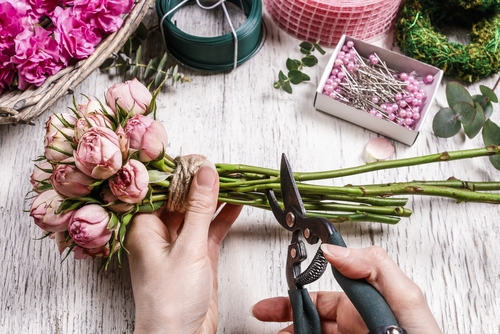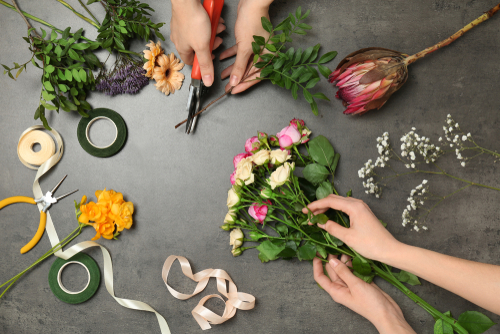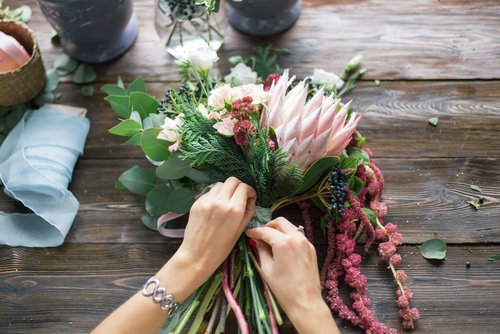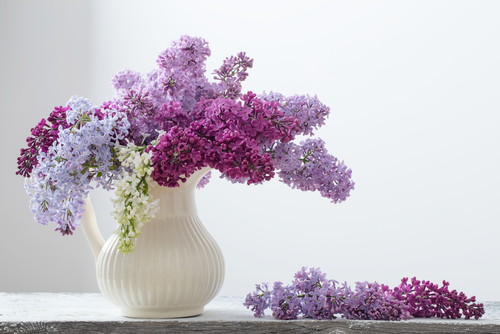While most people talk about Shavuot being the yom tov of dairy, to us fresh flowers take equal firsts. Who doesn’t love a bouquet of fresh flowers?
This year everyone has to alter the way they approach yom tov. While it’s hard to be celebrating without friends and family close by, it’s important to go the extra mile to make the holiday beautiful. For some that means baking cheesecakes, but for others fresh flowers do the trick.
We have put together the following guide with tips and tricks to help extend the lifespan of your flowers. Since you can’t do any of the below suggestions on yom tov (watch Can I Change the Water in My Flowers on Yom Tov for more on this topic), it’s important to you take care of your bouquet from the get-go.
1. Cut the Stems:

Although this one may seem obvious, it’s one of the easiest steps to overlook when you receive or make a bouquet of flowers. It’s best to use sharp garden shears to trim at least one to two inches off the bottom. Additionally, the cut should be made on a diagonal angle as this allows for better water intake. After the initial cut, make sure you re-trim your bouquet every few days.
2. Prune Your Flowers:

You don’t have to be a flower expert to prune your flowers. Simply remove any leaves below the water line. Not only will your bouquet look neater and brighter, pruning also prevents bacterial growth. It’s quite common for flowers to have “guard petals,” which are the outermost petals of the flower. Do not be afraid to remove these as it will allow your flowers to fully open up. Pruning is not a one-time thing and flowers should be checked daily for loose or dead petals and leaves to avoid fast bacterial rot.
3. Water Temperature Matters:

We all know that in order for flowers to survive, your bouquet needs to stay hydrated. Flowers do not last long unless the stems are cut and placed in water. However what you may not know is how important it is that your water is room temperature. Using tap water that’s around 50–60°F is the key to success. Before you fill up your vase it’s important to run your hand under the tap and make sure it’s not too cold or warm. Like in the previous steps, it’s important to change the water every couple of days.
4. Avoid Direct Sunlight:

Keeping your flowers out of direct sunlight is extremely important. Flowers last so much longer when they are kept in a cooler room far away from any appliances that affect temperature, whether high or low (yes, even air conditioners). Although your bouquet might look pretty on the windowsill, not only will the sunlight affect your flowers but any drafts from the open window will cause them to dehydrate quicker. You also shouldn’t display your bouquet near fruit. Sounds funny, but ripening fruit are known to release small amounts of gas, which cause early dehydration.
5. Apple Cider Vinegar + Sugar:

One of the most popular homemade remedies to keep your flowers looking fresh is apple cider vinegar and sugar. Sugar gives the flowers a nutritional boost (most flower food packages are made up with a big percentage of sugar), while the acid from the vinegar works to combat any additional bacterial growth and keep your leaves from turning slimy. Mix two tablespoons of apple cider vinegar and two tablespoons of sugar into a vase with water before adding your flowers.
Always keep in mind that some flowers naturally have a longer lifespan than others. For a long-lasting bouquet, we recommend you stick with roses, daisies, sunflowers, lilies, and freesia, which tend to stay fresher and wilt much slower than tulips, lilacs, and ranunculus.





